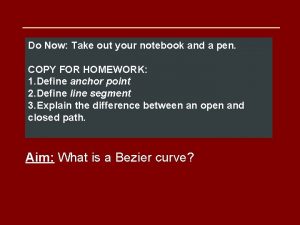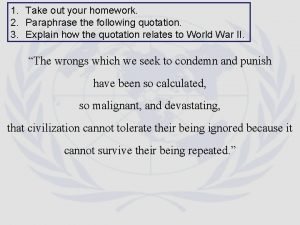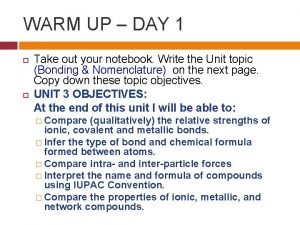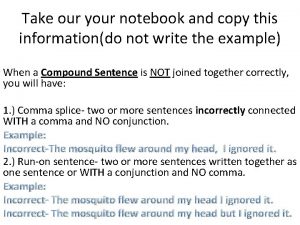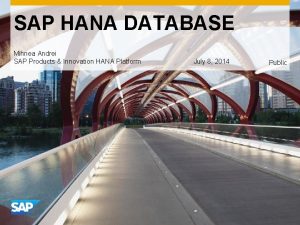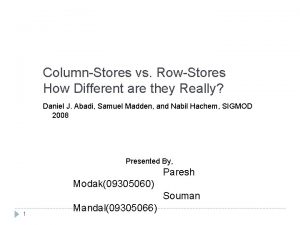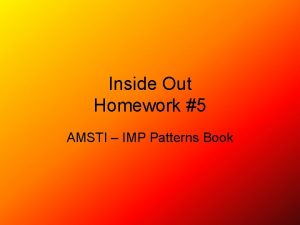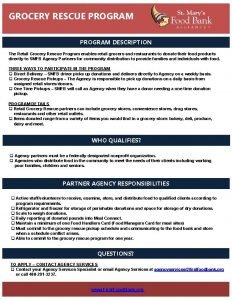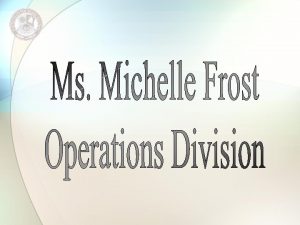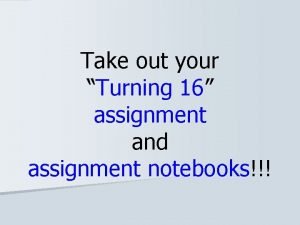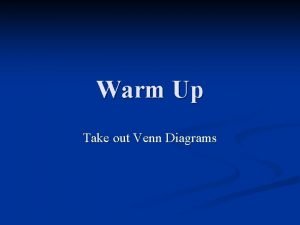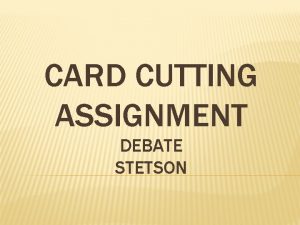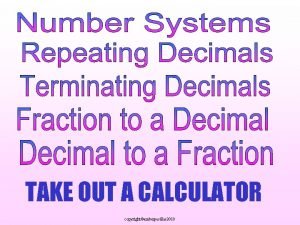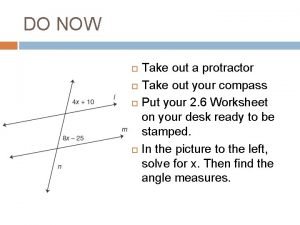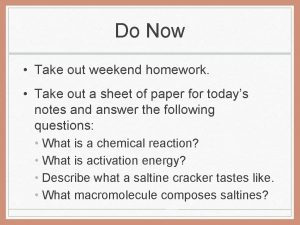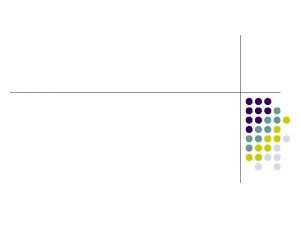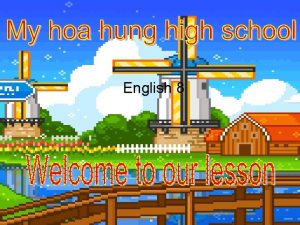Warm up Take out your grocery store assignment






























- Slides: 30

Warm up! • Take out your grocery store assignment. You don’t have to write these answers out. 1. What grocery store did you go to? 2. What did you learn from going to the grocery store? 3. How well do you think the grocery store you went to fit the information we have learned in class? 4. What was the hardest/most unpleasant part of the assignment? 5. Do you recommend I make students do this again next year? Why or why not?

1. 2. 3. 4. 5. 6. 7. 8. Define: Warm up! – Agribusiness – Globalized agriculture – Green Revolution What is the difference between industrialized agriculture and labor intensive agriculture? Would you expect to find more farmers in the United States or Chad? Why? Identify three capital intensive types of farming. Why do the majority of global farmers engage in intensive subsistence farming? What is the most common agricultural practice in the Maghreb and Southwest Asia? Why? Reminder— 1 st weekend tutorials this Friday (3: 30 -5: 30) and Saturday (911) All grades are up to date (I think. )

• Agribusiness--Commercial agriculture characterized by integration of different steps in the food-processing industry, usually through ownership by large corporations. • Globalized agriculture—A system of food production that is global in scale and organization, as opposed to being local in scale • Green Revolution--a large increase in crop production in developing countries achieved by the use of fertilizers, pesticides, and high-yield crop varieties.

Map— Asian Americans in the United States

The von Thunen Model of Rural Land Use

• If you were going to start a business involved in extensive land use, such as livestock herding, would you want your business to be close to a city, or far away? Why?

• Created in the 1820’s • Explain how land use goes from city to complete wilderness • Main focus—Minimizing transportation costs and land costs in agriculture

• Inner Circle—The City Inner market for trade and consumption of agricultural goods • Central-place city—Central marketplace at the center of every society • Land rent (cost) is the highest because people want to be close to where they shop

2 nd Ring—Labor Intensive goods • COMPLETELY OUTSIDE OF THE CITY • Include crops that need constant tending, like garden vegetables and fruit • Produce that require constant transportation • Perishable goods—Because they rot quickly, they need to be close to the city • Land intensive industries-Produce that do not take up lots of land (feedlots)

Teachers Win!!! Woohooo!!!!!! • • • 2010—Teachers win 2011—Teachers win 2012—Teachers win 2013—Teachers win 2014—Teachers win 2015—Teachers win 2016—Teachers win 2017 --… 2018—TEACHERS WIN!!!

3 rd Circle—Forest Goods • Because wood is so heavy and hard to transport, need to be fairly close to the city • Wood has traditionally been needed for construction and energy

4 th Circle—Labor extensive crops • Crops like wheat and corn are less perishable • Also need lots of land to be profitable, and land is cheaper far away from cities, so these crops can be further away from the city • Don’t take as much work as labor intensive crops

5 th, Last Circle—Ranching and Livestock • Least labor intensive (1 shepherd can watch a lot of animals • Also, didn’t need the best land, like you do for more difficult crops to grow • Land extensive, so need lots of land (cheapest land is away from the city) • NOTE: This is where livestock are raised, not where they are taken for slaughter (feedlots)

Criticisms • Doesn’t consider new technology that eases and lowers transportation costs (car, refrigeration) • Von Thunen lived before globalized agriculture • Doesn’t consider new machinery that lowers production cost – Forests now don’t have to be close to markets • Food used for different uses now (fuel/ethanol) • Doesn’t consider varied landscapes—what if there’s a mountain on one side of the city


Similarities with relative location • Both have a central CBD • Both have intensive land use near the CBD, extensive as you move further away • Both use land rent (cost) to explain location • ONE BIG DIFFERENCE: – Burgess—urban land use – Von Thunen—rural land use • What problems do they both have with their models?

Problems with both von Thunen and Burgess • Both assume there is only 1 CBD • Both assume transportation costs the same in all directions • Both assume the terrain is the same in all directions

AP Human Geography 1. How old is von Thunen’s theory? 2. According to von Thunen, how does the cost of land change the closer you get to a market place? 3. Why do labor intensive goods need to be closer to business centers? 4. Why are livestock ranching and grain farming in the last circles of von Thunen’s model? 5. Name and explain two criticisms of von Thunen’s theory.

Rural settlement patterns in MDC’s vs LDC’s

Dispersed Settlement Pattern • In MDC’s, rural settlements are very dispersed (spread out) • Why?

• In MDC’s, rural settlements are very spread out because MDC’s have lots of machinery, so only a few people are needed to farm a large piece of land. • Has contributed to rural-urban migration.

Nucleated Settlement Pattern • More common in LDC’s • Associated with intensive subsistence agriculture • Houses grouped together, with small scale agriculture surrounding the houses

Round Village • Village with a corral for animals in the middle. • Traditional or non-traditional?

Rectangular Survey System (Township and Range) • A grid based system for dividing up land • Found in the United States because the federal government gave out land this way

Dominant Land Survey Patterns in the US

Walled Village • Modern or ancient design?

Grid Village • Modern, or ancient? • Advantages?

Linear Village • What is the central feature of a linear village? Why?


 Grocery vocabulary
Grocery vocabulary Best grocery store design
Best grocery store design Markup vs discount
Markup vs discount Nutrition scavenger hunt worksheet answer key
Nutrition scavenger hunt worksheet answer key A grocery store is selling 6 cans of cat food for $3
A grocery store is selling 6 cans of cat food for $3 One direction shot me out of the sky
One direction shot me out of the sky Take out your notebook
Take out your notebook Take out your homework
Take out your homework Take out your notebooks
Take out your notebooks Homework out
Homework out Take out your homework
Take out your homework Take out your homework
Take out your homework Take out your homework
Take out your homework Take out your notebook
Take out your notebook Write down your homework
Write down your homework Fulcrum load
Fulcrum load Take a point o on your notebook
Take a point o on your notebook Take out your homework
Take out your homework Take out your homework
Take out your homework Take out your homework
Take out your homework Take out your notebook
Take out your notebook Copy the sentence in your notebook
Copy the sentence in your notebook Take out your homework
Take out your homework Row store vs column store
Row store vs column store Row store vs column store
Row store vs column store Take a bus or take a train
Take a bus or take a train You put your right hand in
You put your right hand in Shodor function machine
Shodor function machine Medea notes
Medea notes Signing naturally unit 9.10 minidialogue 3 answers
Signing naturally unit 9.10 minidialogue 3 answers Take out a sheet of paper
Take out a sheet of paper
















